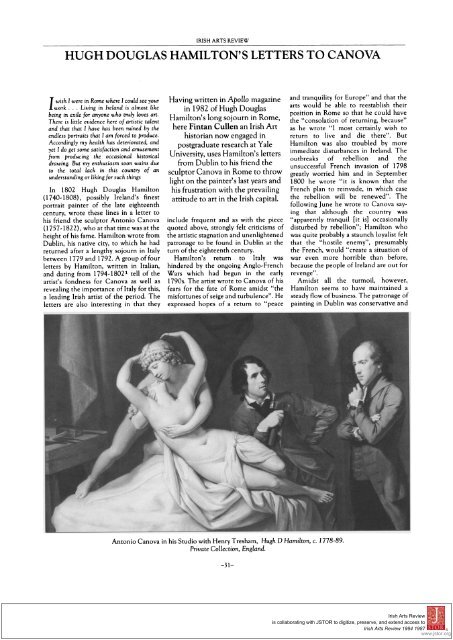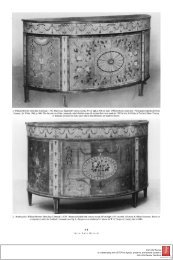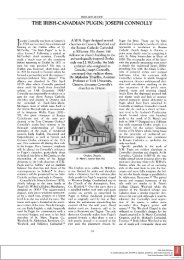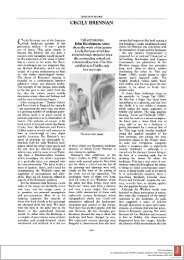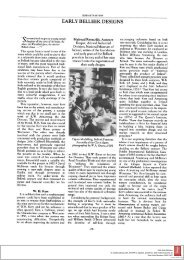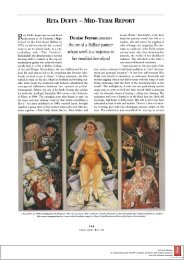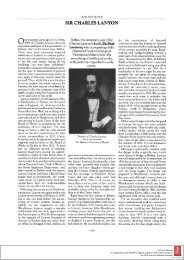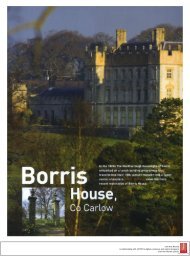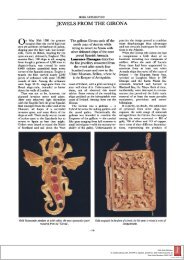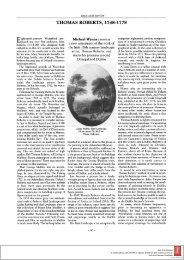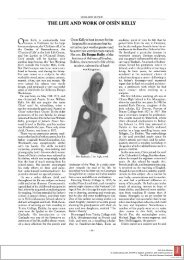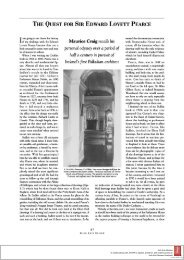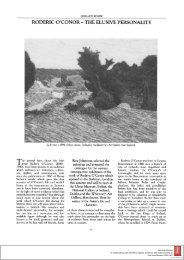hugh douglas hamilton's letters to canova - Irish Arts Review
hugh douglas hamilton's letters to canova - Irish Arts Review
hugh douglas hamilton's letters to canova - Irish Arts Review
You also want an ePaper? Increase the reach of your titles
YUMPU automatically turns print PDFs into web optimized ePapers that Google loves.
IRISH ARTS REVIEW<br />
HUGH DOUGLAS HAMILTON'S LETTERS TO CANOVA<br />
I wish I were in Rome where I could see your<br />
work . . . Living in Ireland is almost like<br />
being in exile for anyone who truly loves art.<br />
There is little evidence here of artistic talent<br />
and that that I have has been ruined by the<br />
endless portraits that I am forced <strong>to</strong> produce.<br />
Accordingly my health has deteriorated, and<br />
yet I do get some satisfaction and amusement<br />
from producing the occasional his<strong>to</strong>rical<br />
drawing. But my enthusiasm soon wains due<br />
<strong>to</strong> the <strong>to</strong>tal lack in this country of an<br />
understanding or liking for such things<br />
In 1802 Hugh Douglas Hamil<strong>to</strong>n<br />
(1740-1808), possibly Ireland's finest<br />
portrait painter of the late eighteenth<br />
century, wrote these lines in a letter <strong>to</strong><br />
his friend the sculp<strong>to</strong>r An<strong>to</strong>nio Canova<br />
(1757-1822), who at that time was at the<br />
height of his fame. Hamil<strong>to</strong>n wrote from<br />
Dublin, his native city, <strong>to</strong> which he had<br />
returned after a lengthy sojourn in Italy<br />
between 1779 and 1792. A group of four<br />
<strong>letters</strong> by Hamil<strong>to</strong>n, written in Italian,<br />
and dating from 1794-18021 tell of the<br />
artist's fondness for Canova as well as<br />
revealing the importance of Italy for this,<br />
a leading <strong>Irish</strong> artist of the period. The<br />
<strong>letters</strong> are also interesting in that they<br />
Having written in Apollo magazine<br />
in 1982 of Hugh Douglas<br />
Hamil<strong>to</strong>n's long sojourn in Rome,<br />
here Fintan Cullen an <strong>Irish</strong> Art<br />
his<strong>to</strong>rian now engaged in<br />
postgraduate research at Yale<br />
University, uses Hamil<strong>to</strong>n's <strong>letters</strong><br />
from Dublin <strong>to</strong> his friend the<br />
sculp<strong>to</strong>r Canova in Rome <strong>to</strong> throw<br />
light on the painter's last years and<br />
his frustration with the prevailing<br />
attitude <strong>to</strong> art in the <strong>Irish</strong> capital.<br />
nclude frequent and as with the piece<br />
luoted above, strongly felt criticisms of<br />
he artistic stagnation and unenlightened<br />
ratronage <strong>to</strong> be found in Dublin at the<br />
urn of the eighteenth century.<br />
Hamil<strong>to</strong>n's return <strong>to</strong> Italy was<br />
lindered by the ongoing Anglo-French<br />
OVars which had begun in the early<br />
L790s. The artist wrote <strong>to</strong> Canova of his<br />
*ears for the fate of Rome amidst "the<br />
nisfortunes of seige and turbulence". He<br />
!xpressed hopes of a return <strong>to</strong> "peace<br />
An<strong>to</strong>nio Canova in his Studio with Henry Tresham, Hugh D Hamil<strong>to</strong>n, c. 1778-89.<br />
Private Collection, England.<br />
-31<br />
and tranquility for Europe" and that the<br />
arts would be able <strong>to</strong> reestablish their<br />
position in Rome so that he could have<br />
the "consolation of returning, because"<br />
as he wrote "I most certainly wish <strong>to</strong><br />
return <strong>to</strong> live and die there". But<br />
Hamil<strong>to</strong>n was also troubled by more<br />
immediate disturbances in Ireland. The<br />
outbreaks of rebellion and the<br />
unsuccessful French invasion of 1798<br />
greatly worried him and in September<br />
1800 he wrote "it is known that the<br />
French plan <strong>to</strong> reinvade, in which case<br />
the rebellion will be renewed". The<br />
following June he wrote <strong>to</strong> Canova say<br />
ing that although the country was<br />
"apparently tranquil [it is] occasionally<br />
disturbed by rebellion"; Hamil<strong>to</strong>n who<br />
was quite probably a staunch loyalist felt<br />
that the "hostile enemy", presumably<br />
the French, would "create a situation of<br />
war even more horrible than before,<br />
because the people of Ireland are out for<br />
revenge".<br />
Amidst all the turmoil, however,<br />
Hamil<strong>to</strong>n seems <strong>to</strong> have maintained a<br />
steady flow of business. The patronage of<br />
painting in Dublin was conservative and<br />
<strong>Irish</strong> <strong>Arts</strong> <strong>Review</strong><br />
is collaborating with JSTOR <strong>to</strong> digitize, preserve, and extend access <strong>to</strong><br />
<strong>Irish</strong> <strong>Arts</strong> <strong>Review</strong> 1984 1987 ®<br />
www.js<strong>to</strong>r.org
IRISH ARTS REVIEW<br />
HUGH DOUGLAS HAMILTON'S LETTERS TO CANOVA<br />
although he longed for more intellectu<br />
ally satisfying commissions, the artist's<br />
income was dependent upon the endless<br />
portraits that he was forced <strong>to</strong> execute.<br />
Writing <strong>to</strong> Canova Hamil<strong>to</strong>n bemoaned<br />
the fact that in Ireland "the arts are given<br />
little motivation" and complained that<br />
there was no one with whom he could<br />
discuss his work. On a more personal<br />
level the <strong>letters</strong> place the artist in a<br />
somewhat pitiable position. Hamil<strong>to</strong>n<br />
believed that the "Roman campagna"<br />
was the only place in which a dedicated<br />
artist should live and work. His inability<br />
<strong>to</strong> return <strong>to</strong> Italy was thus a cause of<br />
deep sadness <strong>to</strong> him. Furthermore,<br />
around 1802-04 the artist's misfortunes<br />
were greatly increased by a serious<br />
nervous complaint induced by the<br />
pressures of having <strong>to</strong> produce so many<br />
portraits2. This extensive portrait<br />
practise finally <strong>to</strong>ok its <strong>to</strong>ll and in 1804<br />
at the age of sixty four, the artist retired<br />
from public commissions. All the same<br />
he still longed <strong>to</strong> return <strong>to</strong> the continent.<br />
The final line of his last known letter <strong>to</strong><br />
Canova, dated 8 November 1802,<br />
expresses the forlorn hope of visiting<br />
Paris and possibly even Italy the follow<br />
ing Spring3 but Hamil<strong>to</strong>n was never <strong>to</strong><br />
leave Ireland again. He died in his house<br />
in Dublin in 1808.<br />
Hamil<strong>to</strong>n's friendship with Canova<br />
had been formed while a resident in<br />
Rome in the 1780s. He had arrived in<br />
Italy in 1779 with a respectable reputa<br />
tion as a master of pastel portraiture, a<br />
position he maintained through commis<br />
sions from distinguished emigres. While<br />
in Rome he got <strong>to</strong> know many of the<br />
leading foreign artists then working in<br />
Italy, including the <strong>Irish</strong> his<strong>to</strong>ry painter<br />
Henry Tresham, the sculp<strong>to</strong>r John<br />
Flaxman, the gem engraver Nathaniel<br />
Marchant, as well as Italian friends of<br />
Canova such as the sculp<strong>to</strong>r's future<br />
biographer An<strong>to</strong>nio d'Este and the<br />
engraver Martino de Boni. Canova had<br />
arrived in Rome from Venice in 1779<br />
and as Hugh Honour has pointed out he<br />
''seems <strong>to</strong> have found the foreign<br />
painters the most interesting... and it<br />
was with them that he made friends"4.<br />
As a "natural xenophile" he nurtured<br />
friendships with the Scottish artists<br />
Gavin Hamil<strong>to</strong>n and Jacob More, the<br />
<strong>Irish</strong> sculp<strong>to</strong>r Chris<strong>to</strong>pher Hewetson,<br />
and also with Henry Tresham and of<br />
course Hugh Douglas Hamil<strong>to</strong>n who was<br />
presumably a frequent visi<strong>to</strong>r <strong>to</strong><br />
' s~~~~~'<br />
Cupid and Psyche in the Nuptial Bower,<br />
Hugh D Hamil<strong>to</strong>n c. 1793-94.<br />
Dublin, National Gallery of Ireland.<br />
Canova's home for in the letter of 1802<br />
he asks after Signora Luigia, the<br />
sculp<strong>to</strong>r's housekeeper.<br />
Hamil<strong>to</strong>n's <strong>letters</strong> show the great<br />
esteem in which he held his famous<br />
contemporary (despite the fact that the<br />
sculp<strong>to</strong>r was seventeen years his junior).<br />
In 1802 he wrote <strong>to</strong> Canova "allow me<br />
<strong>to</strong> express my gratefulness in every way,<br />
especially for the expressions of bene<br />
volence and friendliness that you have<br />
shown me," thanked Canova for writing,<br />
and declared how proud he was <strong>to</strong> be<br />
associated with one so famous.<br />
Elsewhere I have discussed Hamil<strong>to</strong>n's<br />
artistic output during these Italian years<br />
as well as his debt <strong>to</strong> Canova in the<br />
creation of the fine Cupid and Psyche in<br />
the Nuptial Bower which is in the<br />
National Gallery of Ireland5. This<br />
painting dates from ca. 1793-4 that is<br />
after Hamil<strong>to</strong>n's return <strong>to</strong> Ireland. In<br />
terms of subject matter and attention <strong>to</strong><br />
form and line the Dublin painting is a<br />
direct result of Canova's famous Cupid<br />
and Psyche of 1788-89, which is now in<br />
the Louvre. Hamil<strong>to</strong>n's oil reflects the<br />
refined pseudoclassicism of Canova's<br />
embracing couple. Yet some four <strong>to</strong> five<br />
years prior <strong>to</strong> painting the Dublin Cupid<br />
and Psyche Hamil<strong>to</strong>n's admiration for<br />
Canova had found expression in a strik<br />
ingly lauda<strong>to</strong>ry image that included the<br />
sculptured group he so much admired.<br />
-32<br />
The pastel portrait of Canova in his<br />
Studio with Henry Tresham standing by an<br />
early model of the Louvre group is a<br />
deliberate glorification of the sculp<strong>to</strong>r.<br />
Canova is represented mallet in hand,<br />
while his other sculpting <strong>to</strong>ols are on a<br />
bench at the left. Henry Tresham (175 1<br />
1814) the artist companion of Canova's<br />
patron, John Campbell, later 1st Baron<br />
Cawdor, stands <strong>to</strong> the right and seems <strong>to</strong><br />
be pondering some profound thought as<br />
his gaze does not fall on the sculpture.<br />
The deep red curtain in the background,<br />
the shadowed archway and the still-life<br />
at the left, display a new-found gravity<br />
and feeling for linear rhythm that had<br />
not been previously evident in<br />
Hamil<strong>to</strong>n's pastel work. Executed<br />
<strong>to</strong>wards the end of the artist's sojourn in<br />
Italy, this truly great neoclassical<br />
portrait, <strong>to</strong>gether with a small group of<br />
equally large-sized pastels, is a summa<br />
tion of the <strong>Irish</strong>man's expertise in this<br />
medium6. For thirty years Hamil<strong>to</strong>n had<br />
worked almost exclusively as a pastel<br />
artist, producing hundreds of popular<br />
small oval portraits. After a decade in<br />
Italy, where he had studied antique<br />
statuary and had admired the cool,<br />
precise line of Canova, Hamil<strong>to</strong>n<br />
created this masterpiece which tran<br />
scends the limited confines of pure<br />
portraiture.<br />
During the 1780s Hamil<strong>to</strong>n alternated<br />
between pastels and oils. He greatly<br />
enlarged the size of his pastels, as in the<br />
Canova-Tresham portrait, but he also<br />
produced the occasional oil such as a<br />
1783 experiment in his<strong>to</strong>ry painting,<br />
Diana and Endymion which is here<br />
illustrated after recent cleaning7. As<br />
mentioned, the Cupid and Psyche in the<br />
National Gallery of Ireland dates from<br />
the first year of Hamil<strong>to</strong>n's return <strong>to</strong><br />
Ireland. The artist's letter of 1794<br />
informs us that he had actually con<br />
ceived this composition prior <strong>to</strong> having<br />
left Italy and he reminds Canova of the<br />
early sketch he had shown the sculp<strong>to</strong>r<br />
some years before. The attractive<br />
pas<strong>to</strong>ral landscape <strong>to</strong> the right of the<br />
couple with its tree-lined winding river<br />
bank, was possibly part of the early<br />
sketch. A pastel of Era<strong>to</strong>, the Muse of<br />
lyric and love poetry, which has recently<br />
come <strong>to</strong> light, has a similar, if not almost<br />
identical river bank, although it is<br />
populated with a merry group of classical<br />
figures. Era<strong>to</strong> plays her lyre, while a<br />
put<strong>to</strong> who seems <strong>to</strong> be rising from her
IRISH ARTS REVIEW<br />
HUGH DOUGLAS HAMILTON'S LETTERS TO CANOVA<br />
shoulder carries her name and a trumpet. sublime in ideal forms as his execution year. Between 1800 and 1804 Hamil<strong>to</strong>n<br />
This drawing is datable <strong>to</strong> ca. 1790 and was graceful, spirited and correct"8 was represented at the Society's annual<br />
was thus possibly executed around the (both works date from 1804, but neither shows by approximately thirty paintings,<br />
same time as the sketch for the Cupid has yet been traced). An unfinished oil ninety percent of which were portraits9.<br />
and Psyche. Together with the double sketch of Prometheus snatching Fire from An anonymous diarist of 1801 reviewing<br />
portrait of Canova and Tresham, the the Chariot of Apollo also dates from this the exhibition of that year began his<br />
Era<strong>to</strong> can be considered as among one of period. Hamil<strong>to</strong>n's "frequent attacks of account by saying: "As usual in an infant<br />
Hamil<strong>to</strong>n's last pastels, the latter being nerves"l combined with the abundance exhibition, that of this year, consists in<br />
also one of the few his<strong>to</strong>rical subjects of portraits that he was forced <strong>to</strong> the figure line almost entirely of<br />
executed by the artist in that medium. produce presumably prevented him portraits; in fact had the artists practising<br />
In the letter of 1794 Hamil<strong>to</strong>n wrote from completing this particular painting in Ireland inclination, ability and sale for<br />
<strong>to</strong> Canova saying that he had finally and in succeeding years from "executing composition, portraiture is at present so<br />
given up making pastel portraits and that [even] the occasional his<strong>to</strong>rical piece". much the rage, that they have not leisure<br />
he was painting "everything in oils, life The artist's intellectual frustration for any other branch of study"10. The<br />
size as in nature". Yet his later <strong>letters</strong> tell combined with his nervous condition predominance of portraiture over<br />
us of his depression and frustration at was a direct result of the constraints his<strong>to</strong>ry painting in Ireland at this time<br />
not been able <strong>to</strong> create challenging placed on artistic activity in Dublin at was also criticised in the national press.<br />
his<strong>to</strong>rical pictures. The Cupid and Psyche the time. After all those years in Italy A correspondent for the Hibernian<br />
was exhibited in Dublin in 1800 and<br />
only two other his<strong>to</strong>ry subjects are<br />
Hamil<strong>to</strong>n returned <strong>to</strong> a city where no<br />
public exhibition had been held since<br />
Journal11, in discussing the first<br />
exhibition of 1800, lamented the<br />
known <strong>to</strong> have been seen by the Dublin 1780 and where few artists could make a shortage of his<strong>to</strong>rical work and particul<br />
public during these years: a Head of living from their profession. It was not arly the absence in England of the<br />
Medusa and a Head of Tisiphone, until early 1800, at a general meeting of his<strong>to</strong>ry painter Henry Tresham.<br />
described by the Hibemian Magazine as the Society of Artists of Ireland that it Hamil<strong>to</strong>n with his fellow portraitists<br />
''two excellent heads" which "would was decided <strong>to</strong> reestablish annual William Cuming (1769-1852) and John<br />
alone stamp Hamil<strong>to</strong>n an artist, as exhibitions, the first being in May of that Comerford (ca. 1770-1832) seem <strong>to</strong><br />
Earl Bishop of Bris<strong>to</strong>l before the janiculum, Hugh D Hamil<strong>to</strong>n,<br />
Marquess of Bris<strong>to</strong>l Collection.<br />
-33
IRISH ARTS REVIEW<br />
HUGH DOUGLAS HAMILTON'S LETTERS TO CANOVA<br />
have been the leading <strong>Irish</strong> artists <strong>to</strong><br />
show at these important exhibitions.<br />
Among the other contribu<strong>to</strong>rs were<br />
Vincent Waldre, George Chinnery,<br />
Gilbert Stuart, John Hopper and<br />
William Ashford, all foreigners, whose<br />
presence displeased the critic of the<br />
Dublin Evening Post, who gave the<br />
highest praise <strong>to</strong> Hamil<strong>to</strong>n12. By 1804<br />
the dearth of native talent and the diffi<br />
culty in finding Government support for<br />
their endeavours resulted in the Society<br />
of Artists having <strong>to</strong> cancel subsequent<br />
exhibitions and it was not till 1809 (a<br />
year after Hamil<strong>to</strong>n's death) that<br />
another show was held.<br />
The limited artistic possibilities<br />
offered in Dublin were due <strong>to</strong> unenlight<br />
ened patronage and intellectual isolation<br />
caused by the French Wars and the pre<br />
vailing unrest in Ireland. After 1800<br />
those few patrons that did exist were<br />
greatly reduced in number in the wake<br />
of the passing of the Act of Union of the<br />
Parliaments of Great Britain and Ireland.<br />
From 1800 onwards Dublin saw a<br />
Portrait of Francis Rawdon, Earl of Moira,<br />
Hugh D Hamil<strong>to</strong>n, c. 1802-1803.<br />
Private Collection, Ireland.<br />
"the most gracious, and in all, the most<br />
considerate man in England". Canova<br />
was <strong>to</strong>ld that Moira was sure <strong>to</strong> be a<br />
lucrative patron. Unfortunately no<br />
dramatic depletion in the number of<br />
commissions seem <strong>to</strong> have resulted from<br />
the Earl's <strong>to</strong>ur, though three years later<br />
in 1804 Hamil<strong>to</strong>n exhibited a full length<br />
resident peers and parliamentarians who portrait of Lord Moira seated in a study<br />
either returned <strong>to</strong> their country estates with a sleeping dog by his feet.<br />
or <strong>to</strong>ok seats at Westminster.<br />
Hamil<strong>to</strong>n's thirteen years in Italy and<br />
Among Dublin's few art patrons at his friendship with Canova gave the<br />
this time was the very trying and tight artist a greater confidence in his work<br />
fisted young John La Touche, son of the and allowed him <strong>to</strong> produce more<br />
founder of the Bank of Ireland, who in challenging paintings. His succeeding<br />
1791 had commissioned a statue of an years in Dublin deprived him of the<br />
Amorino, or a young Cupid, from intellectual and artistic stimulation of<br />
Canova13. From 1794-1800 Hamil<strong>to</strong>n which he had obviously grown so fond.<br />
acted on the sculp<strong>to</strong>r's behalf in The artist's resentment <strong>to</strong>wards his<br />
attempting <strong>to</strong> arrange a satisfac<strong>to</strong>ry pay native city is thus perfectly understand<br />
ment for this marble, repeatedly inform able and his <strong>letters</strong> can be read as just<br />
ing Canova of his being unable <strong>to</strong> come reflections of their time and not as the<br />
<strong>to</strong> an agreement with La Touche. In mere exaggerations of a sick and lonely<br />
understandable frustration Hamil<strong>to</strong>n in man longing as he did for a return <strong>to</strong><br />
1800 referred <strong>to</strong> La Touche as "the most Rome. The information <strong>to</strong> be gained<br />
indecisive and distracted man" he had from the <strong>letters</strong> is of interest <strong>to</strong> the<br />
ever met. The <strong>letters</strong> <strong>to</strong> Canova tell us of his<strong>to</strong>rian in that it supplies us with a<br />
another somewhat more illustrious more general understanding of Dublin's<br />
patron who also utilised Hamil<strong>to</strong>n's artistic life around 1800. The artist's<br />
friendship with Europe's leading complaints about patronage and the<br />
sculp<strong>to</strong>r. In 1801, Francis Rawdon disinterest in his<strong>to</strong>rical subjects are not<br />
Hastings, 2nd Earl of Moira (later unlike similar complaints made by artists<br />
Marquess of Hastings) (1754-1826) and critics in contemporary London.<br />
requested that Hamil<strong>to</strong>n write him a Furthermore, the Hamil<strong>to</strong>n-Canova<br />
letter of introduction <strong>to</strong> Canova, as he correspondence is of special value in<br />
and his younger brother William, were that it is one of the few original<br />
planning a trip <strong>to</strong> Italy, the latter wish documents that exists <strong>to</strong> tell us of an<br />
ing <strong>to</strong> study architecture. Hamil<strong>to</strong>n <strong>Irish</strong> artist's thoughts and concerns<br />
wrote <strong>to</strong> Canova of Moira's "great during this period of great<br />
nobility" and of his "infinite superiority, political disruption.<br />
social and<br />
his most amiable spirit" and labelled him<br />
Fintan Cullen<br />
-34<br />
N<br />
NOTES<br />
1. Reference <strong>to</strong> these <strong>letters</strong> was first made by<br />
Hugh Honour in <strong>Irish</strong> Portraits, 1660-1860,<br />
exhibition catalogue, Dublin, London, Belfast,<br />
1969-70, p. 51.1 am most grateful <strong>to</strong> Mr<br />
Honour for supplying me with further infor<br />
mation on these <strong>letters</strong>. I am also grateful <strong>to</strong><br />
Sergio Benedetti of the National Gallery of<br />
Ireland for help in the translation. The <strong>letters</strong><br />
are in the Biblioteca Civica in Bassano del<br />
Grappa, near Venice: Mss Canoviani,<br />
Epis<strong>to</strong>lario V, 495, 3491 (May 1794) and<br />
Epis<strong>to</strong>lario Scel<strong>to</strong> 11, 79, 1554-6 (30<br />
September 1800, 10 June 1801 and 8<br />
November 1802). For a<br />
biographical<br />
account<br />
of Hamil<strong>to</strong>n and his work as well as a check<br />
list of his oil paintings see my forthcoming<br />
contribution <strong>to</strong> the Walpole Society, 1984. The<br />
first such check-list was in W.G. Strickland's<br />
A Dictionary of <strong>Irish</strong> Artists (2 vols.), 1913,<br />
vol. 1. pp. 427-445.<br />
2. It is estimated that in the decade following his<br />
return from Italy Hamil<strong>to</strong>n produced some<br />
150-200 portraits. It is unlikely that the artist<br />
had a studio of assistants and thus produced<br />
his portraits single-handedly.<br />
3. Hamil<strong>to</strong>n's hope of visiting the continent<br />
would have been made possible by the<br />
cessation of hostilities in Europe following the<br />
signing of the Treaty of Amiens in the Spring<br />
of 1802.<br />
4. Hugh Honour, "An<strong>to</strong>nio Canova and the<br />
Anglo-Romans, Part 11, The First Years in<br />
Rome", Connoisseur, CXL111, December<br />
1959, p. 225.<br />
5. Fintan Cullen, "Hugh Douglas Hamil<strong>to</strong>n in<br />
Rome, 1779-1792", Apollo, CXV, February<br />
1982, pp. 86-91.<br />
6. The pastel was quite appropriately included in<br />
the vast Age ofNeoclassicism exhibition in<br />
London in 1972, Royal Academy and Vic<strong>to</strong>ria<br />
& Albert Museum, no. 133, pp. 88-9.<br />
7. For a discussion of this painting as with the<br />
Cupid and Psyche, see Apollo, op. cit.<br />
8. T.B.L, "The Late Hugh Hamil<strong>to</strong>n, Esq.",<br />
Hibernian Magazine, 1810, p. 272.<br />
9. For an account of public exhibitions in Dublin<br />
at this time see Strickland, op. cit., vol. 11, pp.<br />
599-600. Fora listing of the paintings<br />
exhibited by Hamil<strong>to</strong>n (information on which<br />
comes from contemporary newspapers) see my<br />
check-list in the Walpole Society, op. cit.<br />
10. Anonymous Journal, Dublin, Royal <strong>Irish</strong><br />
Academy, ms24K14 (February-September,<br />
1801), f. 244.<br />
11. 18 June, 1800.<br />
12. 27 May, 1802.<br />
13. Hugh Honour, "Gli Amorini del Canova",<br />
Arte lllustrata, VI, nn. 55-56, dicembre 1976,<br />
pp. 312-320. The marble cannot now be<br />
located.<br />
RIGHT<br />
Diana and Endymion,<br />
Hugh D Hamil<strong>to</strong>n, 1783.<br />
Private Collection, England.
w<br />
-<br />
'4'-7


